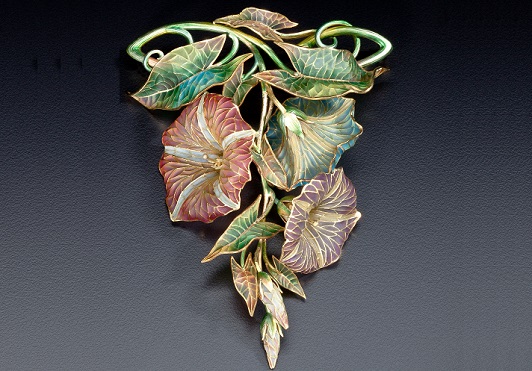
Between 1800 and 1900, jewelry and jewelry-wearing evolved from a “privilege of the aristocracy to a necessity of the bourgeoisie,” according to Ulysses Grant Dietz, who served as the decorative arts curator of the Newark Museum for 37 years. In a January talk titled “Beyond Aristocracy: Style Setting and Social Climbing with Jewelry in the 19th Century,” he traced the shift from wearing jewelry to show status and power, to choosing pieces because of intellectual and cultural awareness.
“And through it all,” he said, “the perception of aristocratic pretension lingered, imbuing all jewelry with a sense of elegance and upward mobility.”
As far back as the ancient Egyptians, Romans and Greeks, aristocrats have used jewelry as part of their display of power, Dietz pointed out. “Jewelry has always implied status first, ornament second,” he observed, noting that in the 19th century, it was the aristocratic market that drove the industry. “In Europe and America, as well as Asia, where there were Europeans living, the rising middle class, the affluent bourgeoisie, becomes the next great market, and they are looking to the aristocracy for their models. And the core of that continuum is parures, or suites of jewelry, and big stones.”
The tourist aesthetic
The Americans who fell into that upper-middle-class category often visited Italy as tourists, and the cameo became their jewel, continued Dietz. “Evocative of the classical world, the cameos were touristy, but they were also about art as well as romantic evocations of the ancient world. That’s why they became very big with the middle class. More than just souvenirs, they served as a link to the past, a reminder of all this magical antiquity floating around in Europe that we don’t have in America.”
Micromosaic styles were also popular among tourists, he said. “This jewelry was aimed at a very wide market, but specifically at an affluent, educated middle-class buyer, for whom the jewelry was very meaningful in an intellectual way. The preciousness of it is there, but secondary. This is about art and intelligence and emotion, not status and power and pretense.”
These styles marked the difference between the classes, according to Dietz: diamonds for the aristocracy, versus emotive jewelry, cameos and micromosaics for the upper middle class.
“Middle-class people can be very rich, but they’re not aristocrats,” he noted. “They’re not in power.”
Works of art
Also finding their place in the market were the Orchid brooches Paulding Farnham created for Tiffany & Co. in the latter part of the 19th century. These beautiful pieces were about Tiffany creating works of art as well, so “the meaning of this is exclusive, but not aristocratic,” said Dietz. “It’s about the intellectual embrace of jewelry as an art form.”
In that vein, he pointed to an Englishwoman named Charlotte Newman, who signed her work “Mrs. N.” She became a royal jeweler in the 1880s, trained by art jeweler John Brogden, who made pieces for smart, wealthy people who knew what they were looking at.
An aristocratic symbol
When the Gilded Age — the era from the end of the Civil War to World War I — kicked in during the 1870s, a growing group of super-rich Americans became another force, according to Dietz. “Jewelry starts in the 19th century as an aristocratic thing and is embraced by the rising middle class, especially in America, where there is no aristocracy. Then, at the end of the 19th century, the aristocratic vocabulary comes back because these very rich women want to distinguish themselves as American aristocrats.”
One of the most powerful upper-class symbols of that time, he said, was the pearl choker. “This tall dog-collar-like necklace of pearls, with or without diamonds mixed in, became the badge of American aristocracy, a symbol of being part of this elite group.”
The two parallel paths of 19th-century jewelry — the early middle-class demand for “meaningful” pieces, and the desire for aristocratic badges among the very rich in the Gilded Age — continued into the 20th century, he observed, “with the added twist of jewelry as art...and [the] Arts and Crafts [movement], which prized handcraftsmanship and quality construction.”
Image: Collection of the Newark MuseumArticle from the Rapaport Magazine - March 2019. To subscribe click here.